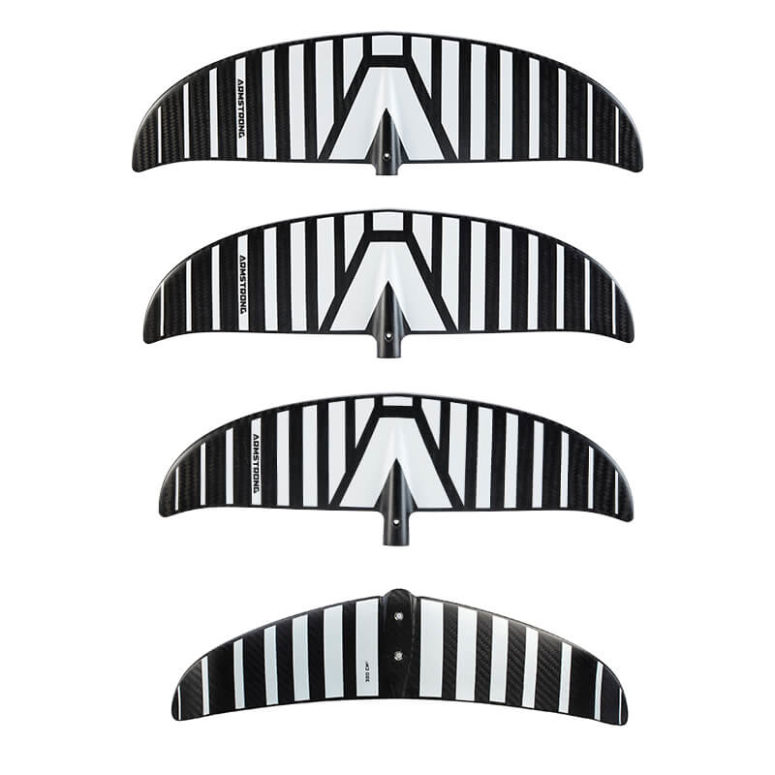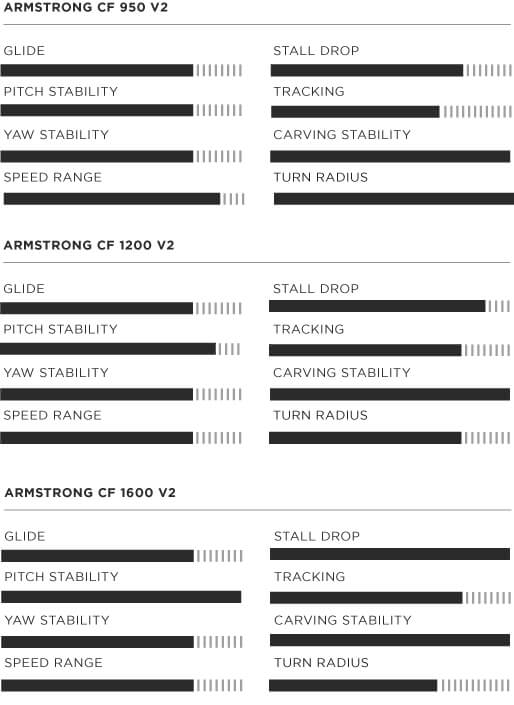

When you purchase gear through links on our site, we may earn a small commission. Here’s why you can trust our tests and our affiliate partner.

It’s a mark of how far foiling has come in the last four years, when popular brands such as Armstrong start revisiting their first release beginner-oriented CF range for a comprehensive second iteration tune up. Armstrong’s ingenious modular A+ system has been in place for over a year now with elegant drag free connection points with the integrated fuse, and all M6 titanium fixings keeping things super tight, corrosion free and lightweight.
As standard in its foil set package, the CF V2 system comes with a 700mm titanium fuse, 100mm longer than the standard, and a CF300 V2 tail. This revised tail is quite a carbon sculpture and has a lot of curvature across its span, with a deep anhedral dip in the center and an opposite dihedral flick into the tips. Everything comes in well-tailored protective storage bags which in our experience stand up to tough day-to-day use.
The 1600 is what most aspiring mid or light weight foilers should be considering for early days surf and wing use. Its amiable and confidence-inspiring characteristics are going to make your first steps as pain free as possible. Lift is early and gradual, requiring a minimum of power from the wave or wing, and overall speed range is wide and comfortable. With the extended fuse and ultra-well behaved CF V2 tail, the system is very stable in all of its axis, and you have time to pre-empt any errors in user input. If it does start to fall out of its flying range, what really impressed us was the softness of the stall characteristics. It seems to really dull any impacts and drop you down gently. The other bonus is that this is nothing like a slow locked-in beginner foil – we were clocking some decent GPS speeds on it for its size, and when pushed to the top of its range it doesn’t seem to build much front foot pressure. Mobility, particularly in the roll and yaw axis, is progressive and not too tracky. We found the 1600 particularly great in small to mid-size conditions with the SUP.
The 1200 is going to be a perfect platform for sub 80kg novice prone foilers, where the wide sweet spot in the speed range and predictability is going to handle a whole host of wonky take offs and not throw you off straight away in your formative stages, plus provide enough agility and pumping ability to see you well into your intermediate stages. With wing propulsion, the 1200 is going to be the go-to size for mid-weight intermediate riders and more positive wind and water conditions; it’s a legit platform for general freeride and instils a smooth and controlled character to your riding. We found the HS232 tail paired particularly well with this for a super smooth and balanced setup for learning tacks and 360s.
The 950 is the surprise of the bunch with an enthusiastic and performant nature. Tune it up with a shorter fuselage and the HS232 or HA195 tail and it’s a performance wing that might worry its higher aspect siblings, particularly in terms of reassurance in maneuverability and in less-than-perfect sea states. Driving a big turn through some horrible chop or current, the level of support and stability present gives you massive confidence to push harder where previously you may have been more tentative. In surf we were extremely impressed with the snappy yaw turns it can produce, with the impressively low stall speed giving you a high degree of support when your speed drops. As a bonus, it’s a perfect size when kite powered as well.
It’s also worth noting that the CF system we received was completely silent out of the box. No irritating flute noises or vibrations to report here. We found the competitive light weight of the system also meant tasks like carrying your board are simply easier. What we also need to stress is the complete cross compatibility of the range. Any sizes can be spiced up with the HS232 or HA195 tail wings and shorter fuses, which builds some serious potential longevity into the CF range.
Advanced riders shouldn’t write off the CF system, particularly for difficult conditions, aerated water, current, and on/off wind conditions. The level of support through lulls or turbulence and innate stability could literally make or break the session when things are more on the unpredictable side. The truth of the matter is you’re going to be flying more and learning more.
With the surf and wake disciplines evolving fast and the wingfoil boom well and truly upon us, it makes a lot of sense for Armstrong to give the CF range a makeover, with the simple intention of making foiling as accessible as possible, and the perhaps not so simple task of building some longevity into the range, and from this perspective it’s nothing short of a design triumph.
The take home for me was the elegance in the system – it’s a far cry from a clunky beginner foil with a limited range and rides in such a smooth and composed manner. For a (fairly) advanced rider, revisiting a more moderately designed wing after months of high-aspect testing was enlightening, it reminds you of what you actually require from a foil, particularly in less-than-ideal water and wind conditions.
The new CF V2 range is the system most aspiring riders should probably be using. In the larger sizes it provides an ultra-stable entry point to foiling sports without the hinderance in top end that beginner-focused foils often suffer from, and the 950 is so delightfully entertaining and easy to ride, everyone should try it regardless of their level. RB
